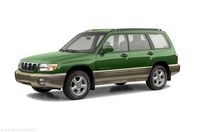Review: 2003 Subaru Forester XS
SEE ALSO: Subaru Buyer's Guide
2003 Subaru Forester XS Base price: $20,545 Price as tested: $25,445 By Des Toups The Subaru Forester, new from the ground up for 2003, remains the car-lover's cute-ute. It's interesting to drive, it's reasonably roomy, and it has what surely must rank as the industry's largest sunroof. It's handsome. It can be loaded with luxuries such as heated leather seats, automatic climate control and a six-disc in-dash CD changer. It's easy to park and a relief at the gas pump, and even with every box on the option list checked, rolls into showrooms for $26,000. Of course, most of that was true for the 2002 model as well. The wholesale makeover nets a driver better brakes and hill-holding clutch on manual-transmission models, more airbags and a slightly more upright driving position. But the Forester is no roomier and no faster for 2003. In a segment where the bar has been raised dramatically forward in recent years – drive a new Toyota RAV-4 or Ford Escape – this timid remake allows the pack to catch up. Newer cute-utes enjoy carlike responsiveness. The redesigned Honda CR-V’s four-cylinder now produces 160 silky horsepower, and it’s quick when paired with a crisp automatic transmission. The Escape and its twin, the Mazda Tribute, with their 200-horsepower V-6, are veritable rockets. The Subaru carries over a 165-horsepower four-cylinder with its lumpy, old-Volkswagen engine note, the product of its trademark “boxer” piston arrangement (The pistons face each other horizontally rather than sit upright.) The Subaru is far from underpowered, but especially when hitched to a slow-shifting four-speed automatic, always sounds like it’s working hard. Subaru promises a turbocharged model, with 217 ponies, soon, which ought to make the relatively lightweight, 3,200-pound Forester positively haul (rivals such as the Jeep Liberty can weigh a half-ton more). In the meantime, those in search of a more sprightly Forester had best opt for the stick. This year the hill-holder clutch returns, using the parking brake to keep the car from rolling when stopped on an incline. Very handy, especially in gridlocked, hilly cities such as Seattle. Newer cute-utes are roomier, and here, too, Subaru has made little progress. The front seats are wider than before – a good thing – but the rear is still best suited for children. If the front passengers are tall, a rear-facing child seat is a tight fit in back. At least Subaru has rearranged the dashboard to put the radio at the driver’s fingertips rather than at the hard-to-reach bottom of the center stack, and there’s a more refined look to the whole interior. But there’s evidence of cost-cutting, too: The door pulls – an item a driver will touch a dozen times a day – feel like the cheap plastic they are, and the visors are covered in the flimsiest of vinyls. In general, though, the materials feel more substantial than those in the Escape or Saturn Vue, the atmosphere less plastic than in the Hyundai Santa Fe, and the feel more sophisticated than in the Honda CR-V. On the outside, the makeover is a success from most angles, though even current Forester owners might not notice how much has been done. The Forester looks bigger than before – it isn’t – and a black surround neatly extends the lines of the rear hatch. The front is redone in Japanese Anonymous; it looks just like the front of a Suzuki Esteem. In all, the Forester looks like what it is, a station wagon with a tall greenhouse, rather than a high-riding SUV-wannabe. If you believe that the ability to dodge an accident is the ultimate safety feature, then the Forester is the safest cute-ute you can buy. The Forester handles like a car, not a truck, aided for 2003 by quicker steering and the addition of 16-inch wheels and bigger tires (the more tire, the more grip). All the new little SUVs handle worlds better than their heavyweight brethren, but the Subaru imparts a comforting confidence. There’s little body lean, and the steering allows a lot of information about road conditions to reach the driver. Those bigger tires and new, bigger brake rotors with standard antilock give the Forester ferocious stopping power. If that’s not enough, a beefier frame, dual-stage front airbags and head-and-side airbags should help improve passengers’ chances in a collision. New crash-test ratings haven’t been released; the older model received a top “good” rating from the Insurance Institute for Highway Safety. The Subaru’s all-wheel-drive system is as transparent as any, with no binding in tight corners or obvious friction in the drivetrain, yet it’s always splitting power between the front and rear tires. Most of its rivals wait until grip starts to erode, then send power to the rear wheels with a delay and clunk. EPA gas mileage numbers were unavailable, but the last-generation automatic Forester was rated at 22 city/27 highway. If anything, the newer model, which is more slippery to the wind and weighs less than before, should do better. The Forester’s winning personality, its agility and handy size, its buttoned-down feel and raft of luxury features should continue to win it friends. But with buyers demanding more space, more power and higher seating – three reasons the much-recalled Escape remains a best seller – the Subaru isn’t the obvious choice it was just two years ago. Des Toups is a Seattle free-lance writer whose work has AutoWorld magazine, The Seattle Times and newspapers nationwide.



